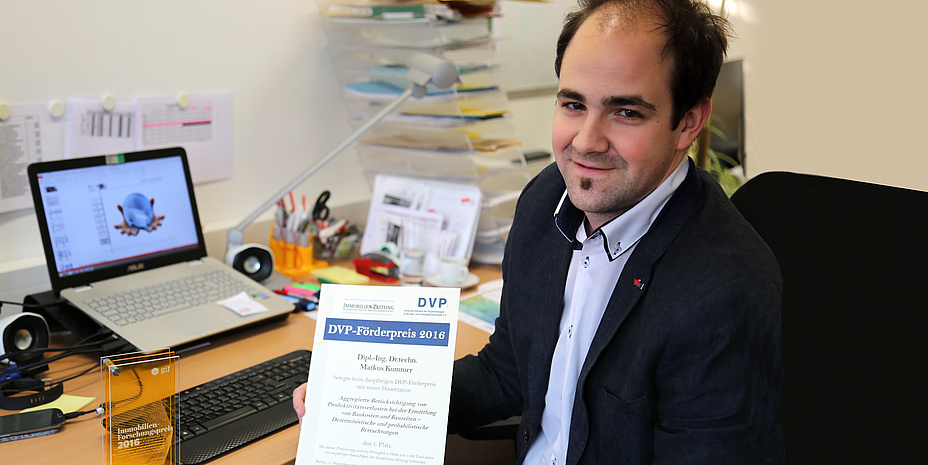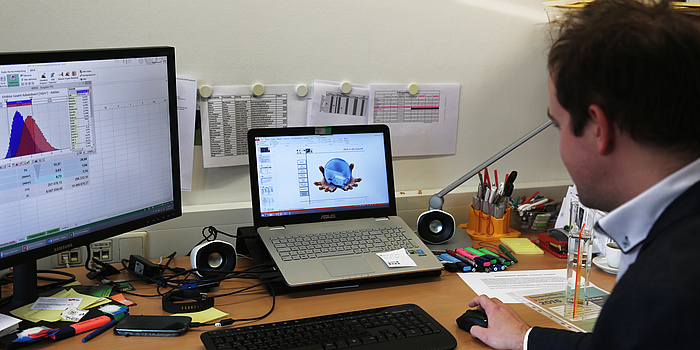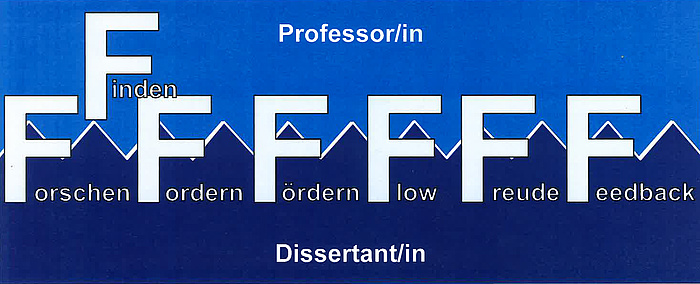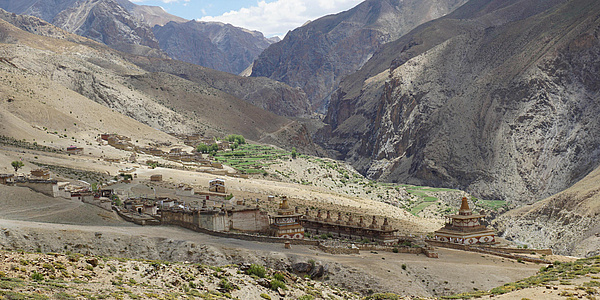Chance as factor of forecast

News+Stories: Your doctoral thesis deals with uncertainties in construction planning. Can you explain the basic ideas?
Markus Kummer: In my doctoral thesis I looked at building costs and building times of reinforced concrete structures in structural engineering. Reinforced concrete parts have been produced in a very similar way for years. You would think that meanwhile all the calculation factors, such as cost values – in other words, the relationship between wage hours and quantity of units produced, and use of equipment and materials, etc. would be known precisely in order to be able to calculate the building time and building costs for example for a reinforced concrete wall.And we basically know the relevant factors. The problem is, the circumstances under which a reinforced concrete wall is produced are always different. This means, specifically, there are always different people involved in the project, there is always a different environment, weather conditions are always different, there are always different teams from different firms working together, and the planning and the tendering process is sometimes better and sometimes worse. All these are factors which in all probability will have an effect on productivity.
So when it comes to implementation, not all reinforced concrete walls are the same?
Markus Kummer: Exactly. Human factors, work environment and environmental conditions make all the difference. All these can lead to loss of productivity and have to be taken into consideration. When we calculate building costs and time, we’re making predictions about the probability of the occurrence of influencing factors – and always based on the current level of information. The aim of my doctoral thesis was to systematically depict uncertainties, some of which interact with each other, by means of distribution functions.Does this mean there are both risks and opportunities?
Markus Kummer: When we plan ahead, the view of the future is shaped by uncertainties whose consequences could positively or negatively deviate from our objective. Negative deviation we define as risk; positive as opportunity. For instance, how uncertainties have an effect on productivity always depends on what I have previously counted on; in other words, the basis I choose for my decisions. The opportunities or risks are thus accordingly higher.At the end, I know the fluctuation range within which a result can move – and also the probability.
Is including uncertainties in forward planning a new approach to your research area?
Markus Kummer: This has been considered for a long time. Specifically, I’ve built on Christian Hofstadler’s research results on productivity and loss of productivity, and combined non-linear interrelations with the systematic consideration of uncertainties. When I calculate something using school maths, I come to a result which is either right or wrong. In practice, there’s the question of which figures to use. The example of the reinforced concrete wall shows that I’m using values which fluctuate within a certain bandwidth. And of course, at the end the results also fluctuate accordingly. To achieve more realistic results, I have to take into account uncertainties based on practical experience right at the beginning. For this I have to use Monte Carlo simulations. At the end, I know the fluctuation range within which a result can move – and also the probability.What are Monte Carlo simulations? Mathematics for gambling?
Markus Kummer: There is actually a connection. The Monte Carlo method uses random numbers to solve mathematical problems. Today these numbers are produced on computers using random generators. Earlier, we had to generate them mechanically from a large number of random experiments. The results of the roulette wheel from the bank at Monte Carlo were regularly publicly displayed – winning random numbers, as it were. They form the basis for methods relying on such numbers.
How do you deal with uncertainties in your private life?
Markus Kummer: That’s a difficult question (thinks about it). I would call myself a reflective type of person – a person who plans in advance and structures his life, but also a person who is aware that there are also uncertainties. But I calculate them into the equation, in as much as one can, or I at least integrate them into the decision-making process.How did you start calculating uncertainties?
Markus Kummer: During my <link _self int-link-internal internal link in current>Construction Management and Civil Engineering master’s programme, I and a colleague of mine took part in an international student competition of the formwork manufacturer PERI – very successfully as it turned out. We had to set up a whole project, including calculations, tendering and plans. In the course of this we had to fall back on values from the literature, experience and/or experts for particular numbers. My aha experience was that these values always had a certain scattering. And then there was a talk at TU Graz on the topic of risk management in which random numbers were brought up.And after this you couldn’t leave Monte Carlo simulations alone?
Markus Kummer: Christian Hofstadler, my diploma thesis supervisor and head of the Institute of Construction Management and Economics at TU Graz, had already investigated in depth and used simulations in construction management questions, and had also published results in several publications, and wanted to move the topic ahead. So I met him at the right time. Not only during my diploma thesis but also because of it, the sheer size of the area of application of such simulations in construction management became clear to me. However, it’s not limited to economic issues, but goes far into construction questions, such as logistics and construction work flow. In this way, Christian Hofstadler’s offer justified going into the topic in depth in my doctoral thesis.
What are you currently working on?
Markus Kummer: At the moment, Christian Hofstadler and I are involved in other research projects, such as UNAB or <link https: www.tugraz.at tu-graz services news-stories planet-research einzelansicht article die-ultrahochleistungsfahrbahn-im-ersten-stock _blank int-link-external external link in new>QUICKWAY. The first project deals with systematically looking at sustainability requirements in planning and project management process and developing a rating system while taking into account uncertainties. In the second project, we carried out life-cycle costs calculations for a novel traffic system – high-level carriageways made of ultra high-strength concrete – using Monte Carlo simulations.Do you also take part in teaching?
Markus Kummer: Yes, as a university project assistant, I supervise practicals in the “Formwork and scaffolding”, “Work scheduling and logistics in construction management” and the “Managing risks and opportunities in construction economics” courses. Christian Hofstadler and I created the “Managing Risks and Opportunities in Construction Economics” practical in the course of our current research. It’s starting in the summer semester. We’re very excited about how its going to be received.For the students, taking part in this competition is pure practical experience. Although they have to apply themselves so intensively, the students’ feedback is very positive.
Not only did you win two prizes in Germany in 2016, but together with Christian Hofstadler you led a winning student team in the Doka company competition?
Markus Kummer: Each year we try to put together a team for the competitions of the formwork and scaffolding manufacturers <link https: www.doka.com at index _blank int-link-external external link in new>Doka and <link https: www.peri.at _blank int-link-external external link in new>PERI. The competition is advertised alternately by the two companies – both are world market leaders in this segment. For the students, taking part in this competition means more work than they’ll be accredited for in the study programme, but it is pure practical experience. Participants are given the plans of a realised project, and have to draw the formwork, and do the tendering and calculations as well as plan the construction work flow and logistics for the construction management. Although they have to apply themselves so intensively, the students’ feedback is very positive – even more if they manage to win first place, as they did for the first time in 2016.
Kontakt
Dipl.-Ing. Dr.techn.
Project assistant
Institute of Construction Management and Economics
Lessingstraße 25/II
8010 Graz, Austria
Tel.: + 43 316 873 6751
<link int-link-mail window for sending>markus.kummer@tugraz.at




